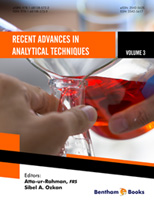This book is Edited by: Atta-ur-Rahman, Sibel A. Ozkan, Published on: January 12th, 2019.
Recent Advances in Analytical Techniques presents comprehensive chapters on recent trends related to ionic liquids, chiral analysis, multi-parameter flow cytometry, electrospun nanofibers, neutron activation analysis, enantioselective chromatography, Ru(II)-polypyridyl complexes.
The book is especially written for PhD and post doc students where they find out new information, and new ideas. This eBook will encourage researches to use different kinds of analytical methods in their researches. It was developed by different authors from different countries.
In this e-book, the reader can find different topics in the related chapters as follows: Chapter 1 is about the chiral analysis of methaphetamine and related controlled substances in forensic science. This chapter reviews the current analytical methods, such as spectroscopic methods, separation techniques, including gas chromatography, high performance liquid chromatography, supercritical fluid chromatography and capillary electrophoresis, especially those coupled with mass spectrometric methods are discussed as details for the enantiomeric identification and quantitation of methamphetamine and related compounds.
Chapter 2 covers the low-cost feedstocks for biofuels and high value added products production, using multi-parameter flow cytometry as a tool to enhance the process efficiency. In this chapter, the cell stress response to the most known inhibitors present in low-cost feedstocks will describe.
Chapter 3 is about application of ionic liquids for micro extraction techniques. This chapter gives extensive theoretical and practical information on the possible application of ionic liquids in various separation micro extraction techniques.
Chapter 4 gives some ideas about electrospun nanofibers. This chapter mainly about electrospun nanofibers based separation and detection systems. Chapter 5 is an overview about neutron activation analysis and their application areas. Also, the problems and the advantageous of the technique are pointed out and briefly discussed.
Chapter 6 is related with the non-commercial polysaccharides-based chiral selectors in enantioselective chromatography. The readers can be find the necessary information about the use of non-commercial polysaccharides namely chitosan, glycogen, chitin, pectin and amylopectin and their derivatives as chiral selectors in enantioselective chromatography and alternative polysaccharides derivatives. Lastly, Chapter 7 provides information about Ru(II)-polypyridyl complexes as potential sensing agents for cations and anions. Design, synthesis and applications of cation and anion sensing selective Ru(II)- Polypyridyl complexes are described in this chapter.
I hope that the readers will greatly enjoy reading these excellent articles from eminent scientists in the field.
About the Editor(s):
Atta-ur-Rahman, FRS
Honorary Life Fellow
Kings College
University of Cambridge, UK
Sibel A. Ozkan
Ankara University, Faculty of Pharmacy,
Department of Analytical Chemistry,
06560 Yenimahalle/Ankara,
Turkey
Keywords: Analytical Chemistry, Enantiomers, Gas chromatography, Capillary electrophoresis, Supercritical fluid chromatography, crude glycerol, Flow cytometry, Low-Cost Feedstocks,Dispersive Liquid-Liquid Microextraction, Hollow Fiber-Supported Liquid Membrane Extraction, Single-Drop Microextraction, Electrospun nanofiber, immobilization matrix, nanotechnology, Instrumental neutron activation analysis, Chiral Selectors, polysaccharide chemistry, Fluorescence sensor, ruthenium ii polypyridyl complexes.

